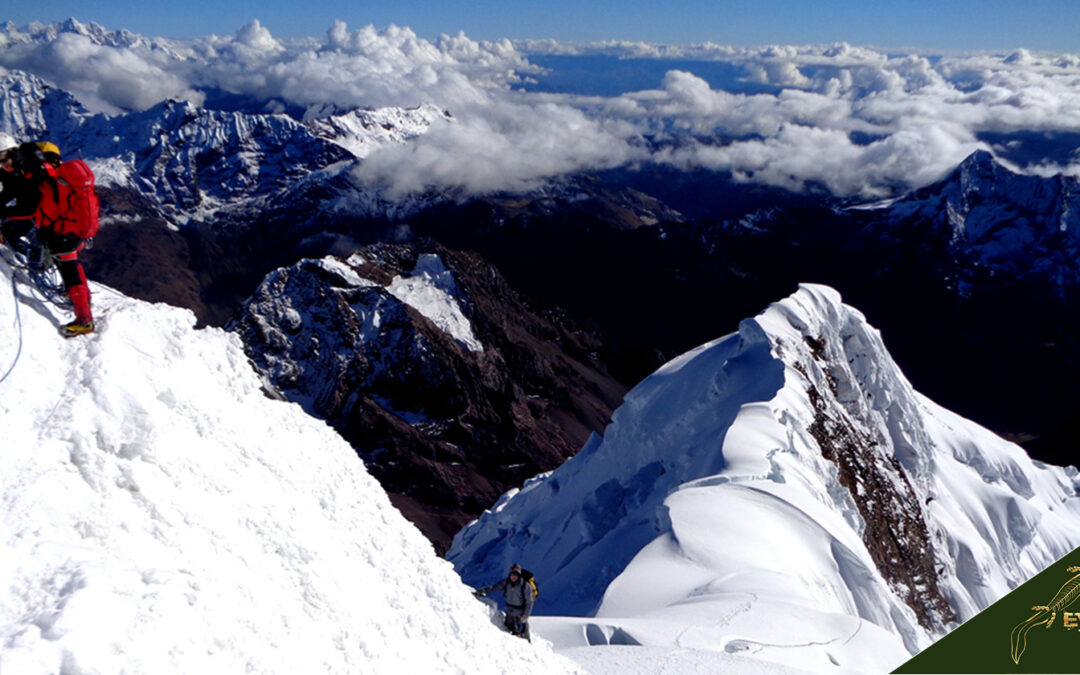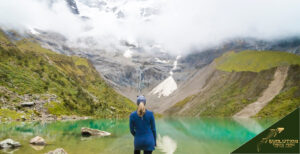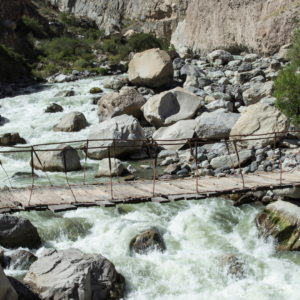What is the Tocllaraju History?
The Cordillera Blanca in Peru is home to a mountain called Tocllaraju, reaching a height of around 6,034 meters (or 19,797 feet). Situated in the Ancash Region, the Carhuaz Provinces Aco District, and the Huaraz Provinces Tarica District, this mountain is nestled within the protected area of Huascarán National Park
The name Tocllaraju can be traced back to its Quechua origins, where “tuqlla” signifies a “trap” and “Rahu” refers to “snow” or “ice.” Thus we can interpret Tocllaraju as a mountain cleverly trapped by snow.
The pioneering ascent of Tocllaraju occurred on July 31, 1939, accomplished by Walther Brecht and Hans Schweizer, both hailing from Germany. They followed the Northwest Ridge, considered the path leading to the summit. This route is classified as Alpine D (/difficult) in terms of difficulty—an alternative route known as the West Face Direct route rates higher at Alpine D+.
The time required to conquer Tocllaraju can vary depending on weather conditions and the climber’s experience. However, it’s quite typical for climbers to dedicate around 4 to 6 days to conquer the mountain, including the acclimatization period and their attempts to reach the summit.
Tocllaraju presents an ascent with its ridges and technical segments. The Northwest Ridge, which served as the path for the climb, is considered quite challenging (classified as Alpine D). Those venturing to conquer Tocllaraju should possess mountaineering experience and expertise and be well prepared for demanding terrain and high altitudes.
The geography encompassing Tocllaraju showcases the awe-inspiring peaks and glaciers of the Cordillera Blanca in the Peruvian Andes. It stands among mountains like Pukaranra and Palcaraju.
The exact count of tourists specifically visiting Tocllaraju isn’t readily accessible. However, the Cordillera Blanca region in Peru entices several mountaineering enthusiasts and adventurous travelers each year thanks to its landscapes and an abundance of peaks fit for climbing. Tocllaraju holds allure among these visitors, captivated by its challenge and sheer beauty.
What does Tocllaraju Mean?
The title “Tocllaraju” originates from Quechua, the language spoken by the native people of the Andes. “Toclla” means “friend” or “partner”, while “raju” means “snowy” or “glacier”. Therefore, Tocllaraju can be interpreted as a “snowy friend” or “glacier friend”. This name is fitting, as Tocllaraju is surrounded by other majestic peaks in the Cordillera Blanca, making it a prominent and recognizable feature of the landscape.
When did Tocllaraju get its name?
The snowcapped peak towers above the Peruvian highlands were not officially dubbed with its current appellation at any specified juncture, for the indigenous tongue had uttered a designation for the massif for generations untold. Nonetheless, records verify that a conglomeration of alpinists from Germanic regions was the premier to summit in 1939 CE, perchance propelling the cognomen into wider currency and codifying its spelling simultaneously.
The ancient tongue uttered amid the lofty Andes has endured for an age, and the heights and waypoints therein oft retain the names in that enduring speech. Those names frequently mirror the lie of the land or import to the tribe, and many were bequeathed by forebears native to the realm.
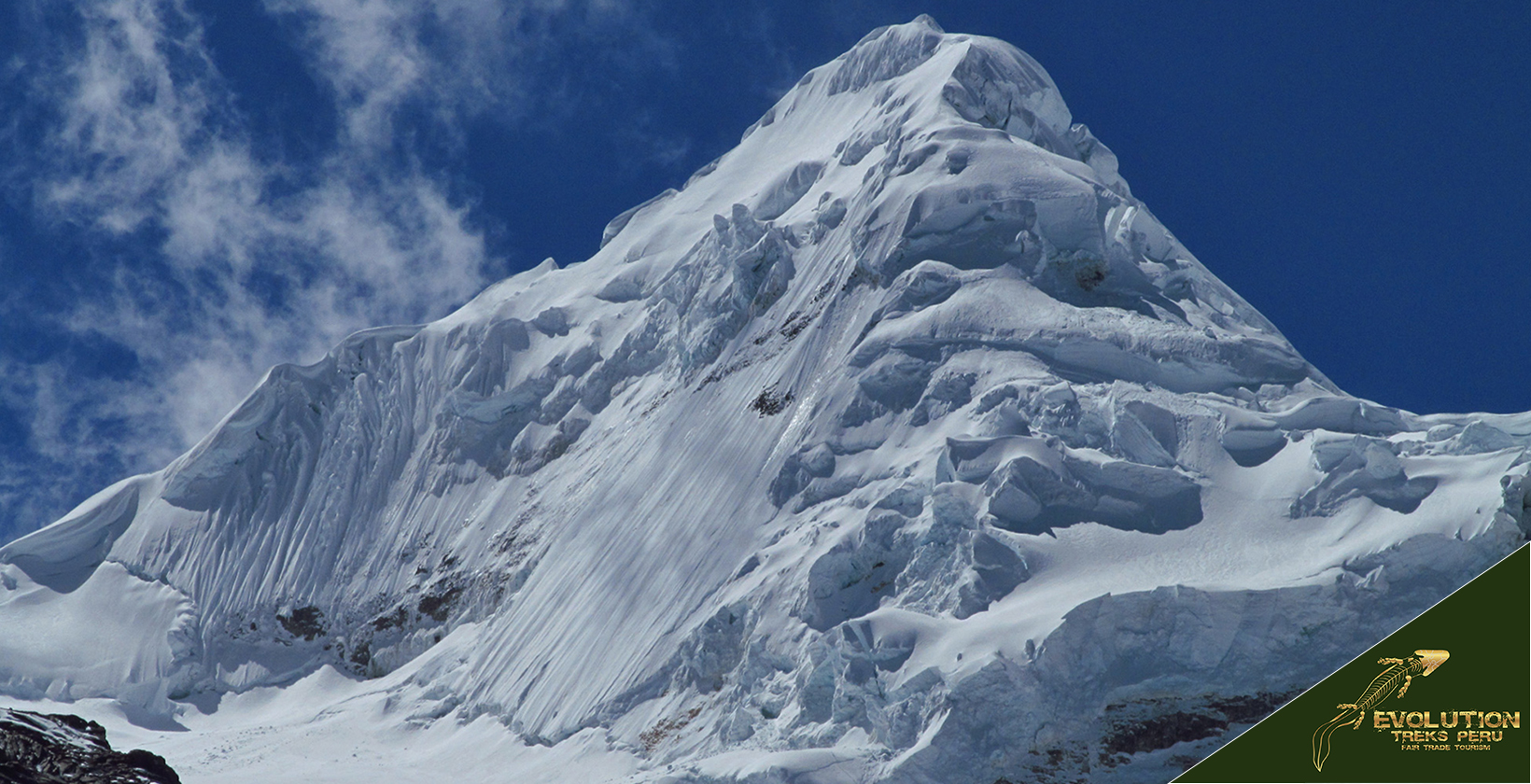
Which Civilization used Tocllaraju for what?
The lofty peak of Tocllaraju pierces the sky within the pale of the Peruvian Andes, not an antiquated settlement of any kind. Hence, no society has employed the mountain for a distinct end.
A multitude of indigenous groups have called the area surrounding Tocllaraju and the Cordillera Blanca range home for a vast number of years. This includes groups such as the Chavín, the Moche, the Wari, and the Inca. These ancient cultures constructed remarkable archaeological locales, like Chavín de Huantar, Kuelap, and Huaca de la Luna. These sites indicate that these cultures were exceptionally adept in architecture, engineering, and creative expression.
The original dwellers of the land have customarily depended on the peaks, such as Tocllaraju, for assorted uses, like chasing, reaping, and farming. The summits and encircling terrain have enacted a crucial part in their civilization and faith and endure as a meaningful fragment of their modus vivendi currently.
What are the theories about the origin of the Tocllaraju?
The Andes’ peaks arose from the earth’s convergence of plates, specifically the South American and Nazca plates, which collided around 65 million years prior. The mountain known as Tocllaraju was birthed through these geological actions and now stands as part of the Cordillera Blanca, a stretch of the Peruvian Andes.
The immense plates rammed into one another, compelling the Nazca plate to slide beneath the neighboring South American plate, an occurrence identified as submergence. This prompted the lofty boulders overhead to be constricted and hoisted aloft, sculpting the lofty summits of the Andes encompassing Tocllaraju.
The mechanisms behind Tocllaraju’s emergence remain enigmatic, though theories abound regarding the mountain’s provenance. While the rock and mineral composition integral to the peak’s constitution have escaped definitive classification, its birth is inextricably tied to the grand-scale forces behind the Andes’ ascent.
Is Tocllaraju Important for Peru History?
Despite its natural wonder, the imposing mountain bears no direct role in the nation’s tale. However, the pale peaks amidst which it looms have long featured in the realm’s chronicles and character.
Native dwellers have long populated the locality encompassing the White Mountains for myriad years, and has stood witness to many paramount pre-Hispanic societies, encompassing the Chavín, Moche, and Wari civilizations. These civilizations have bequeathed a wealthy heritage of aesthetics, architecture, and spiritual credos, which continue to sway the locality.
The Cordillera Blanca mountain range has significantly contributed to the Peruvian economy and progress. This area harbors valuable resources such as ores, aquifers, and arable land and has long functioned as a hub for extraction, crop cultivation, and recreation.
The peaks and valleys of the Cordillera Blanca, including Tocllaraju, have grown into a vital aspect of Peru’s open-air amusement and thrill-seeking travel trade, drawing in spectators from all corners of the globe. The Cordillera Blanca has likewise been ordained as a UNESCO World Heritage locale, acknowledging its exceptional natural splendor and social importance.
Overall, although Tocllaraju itself may not have borne straightaway significance in the annals of Peru, it constitutes a fragment of the vaster Cordillera Blanca chain, which has enacted a cardinal part in the nation’s social, financial, and ecological rise.
Where is Tocllaraju Located?
The peaks of Tocllaraju penetrate the Peruvian sky within the icy Cordillera Blanca, nestled deep in the Ancash province. The Cordillera Blanca’s frosty peaks are but a fraction of the Andes, the extensive mountain range traversing much of South America.
The sole peak of Tocllaraju can be found within the depths of Ishinca Valley, an area frequented by those conquering summits and scaling ascents owing to its closeness to further lofty tips inside the Cordillera Blanca mountains, encompassing Urus, Ishinca, and Ranrapalca.
The municipality neighboring Tocllaraju is Huaraz, a favored hub for voyagers to the Pallid Peak chain. Roughly a seven-hour coach ride from Lima, the capital of Peru, Huaraz possesses assorted lodgings, eateries, and expedition organizers that provide for escapade travel in the territory.
What are the coordinates of Tocllaraju?
The specifications of Tocllaraju are approximately 9.3982° southern latitude, 77.6042° western longitude.
How did Tocllaraju become well-known?
The altitude of Tocllaraju is what has brought it recognition. As one of the Cordillera Blanca’s loftiest mountains in Peru, this peak is sought after for its arduous climbs and breathtaking vistas.
The previously uncharted pinnacle of Tocllaraju was initially surmounted by a conglomerate of German and Austrian mountaineers in 1939. After that, the massif has been conquered on myriad occasions by mountaineers hailing from all corners of the globe. The burgeoning prevalence of mountaineering and escapade tourism within the vicinity has likewise propelled Tocllaraju to ascendancy as a coveted goal for climbers and open-air aficionados.
The lofty Tocllaraju has attracted notoriety beyond the allure it holds for mountaineers. Mishaps, misfortunes, and calamities transpiring on the peak’s flanks, spanning snowslides and lethal plummets, have shone a light on the perils inherent to ascending and helped drum up cognizance of the consequence of safeguards and apt groundwork for any Andean ascent.
What species can be found in Tocllaraju?
The peak of Tocllaraju soars within the Peruvian Andes; hence a plethora of life inhabits its domain. Though the towering elevation of the massif fosters a cruel climate, its confines are home to organisms acclimated to such spartan surroundings.
A selection of flora located within the Cordillera Blanca vicinity, and plausibly upon Tocllaraju, encompasses the Puya Raimondi, a bromeliad genus native to the Andes containing the most substantial flower cluster of any vegetation globally. Additional types of plants in the locale comprise lofty savanna grasses, pad plants, and varieties of moss and lichen.
Regarding wildlife, the Cordillera Blanca area houses native birds, like the crowned Sandpiper-Plover, the Andes Condor, and the Puna Tinamou. The place also contains various mammals, such as vicuñas, Andes foxes, and pumas (mountain lions). Moreover, the waterways and lakes in the district have numerous species of fish and amphibians, comprising the Andes catfish and Telmatobius, a group of frogs adapted to living in elevated lakes.
The seclusion and rough terrain of the area have left much of the diversity of life in the Cordillera Blanca mountains little explored and comprehended. There are likely numerous kinds of creatures inhabiting the locale that science still needs to encounter or catalog.
How is the Map of Tocllaraju Layout?
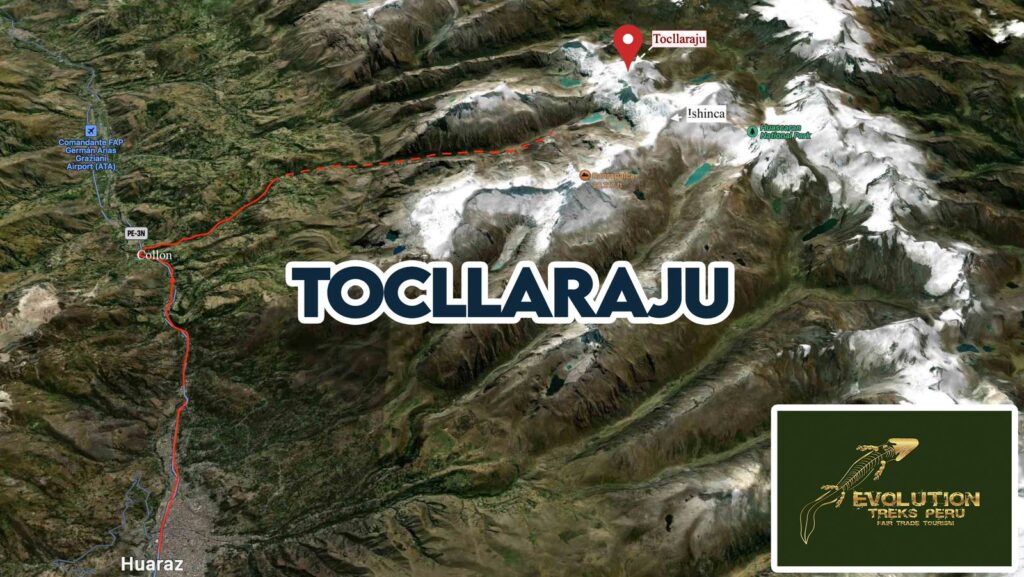
How is the Geography of Tocllaraju?
The towering peak of Tocllaraju rises amongst the Peruvian mountains of the Andes, nestled within the icy folds of the Cordillera Blanca range. A land of lofty summits and plunging gorges, its terrain bears the mark of age-old ice; remnants of frozen rivers still cling to its flanks while frigid pools dot the valley floors below.
The pinnacle of Tocllaraju has sharp edges and various cold masses of ice, including the Santa Cruz ice flow on the northern facade of the summit. The highest points of Tocllaraju have a particular gap, which provides the mountain with its title.
The lofty Cordillera Blanca mountains, home to Tocllaraju, are renowned for their immense height and harsh weather. The area contains various towering summits, most notably Huascarán, Peru’s tallest peak and one of the highest in the continent. The locale also has copious glaciers, though many are swiftly disappearing as a result of shifts in climate.
The topography of the locality is also distinguished by profound depressions and ravines, including the Duck Canyon, which constitutes a prevalent terminus for escapade tourism. The vicinity is furthermore abode to several glacial pools, encompassing Lake 69 and Lake Parón, which form prevalent termini for mountaineering and trekking.
The vista of the Tocllaraju region and Cordillera Blanca mountain chain is breathtaking and diverse, with an uncommon fusion of lofty summits, frozen rivers of ice, and profound gorges which render it a favored haunt for thrill-seeking tourism and open-air leisure.
What is the Geological Profile of Tocllaraju?
The peak of Tocllaraju rises within the Cordillera Blanca range, shaped by Peru’s singular geological past. Molten rock cooled into granite far beneath the surface, while flowing ice and water sculpted the mountain’s facade over time.
The elevated landmass consists primarily of stone, an unyielding mineral formed by solidifying hot fluid within the planet’s outer layer. This rock is difficult to wear down or break apart, which explains why Tocllaraju and other summits in the White Mountains have such a sheer and craggy landscape.
The icy monster is also known for copious frozen rivers, encompassing the northern glacier on its facade. Glaciers emerge when flakes and frost amass over epochs and compress into thick ice, descending due to gravitation. Glaciers constitute a crucial geographical aspect in the pale mountain chain, as they carve the terrain and furnish a wellspring of liquid for the vicinity.
The area around Tocllaraju has been shaped over countless years by the slow crawl of icy masses and other elemental powers, carving a landscape of vales, tarns, and wonders. The Cordillera Blanca is famed for scenes of natural splendor that draw travelers seeking thrill and trail, especially those aspiring to scale peaks or trek winding ways.
What are the Hiking Routes near Tocllaraju?
In the vicinity of Tocllaraju, you can find hiking trails that grant access to the valleys and mountains in the Cordillera Blanca. Here are some noteworthy routes:
Quebrada Ishinca: This is how to reach Tocllaraju and offers a gentle trail leading up the valley. Climbers attempting the Northwest Ridge route of Tocllaraju generally prefer this route. Along the hike, you’ll be treated to breathtaking views of glaciers cascading down from the ridge between Tocllaraju and Palcaraju.
Quebrada Akilpo: West of Tocllaraju, this valley serves as a path to reach the mountain. The route takes you through Quebrada Honda and its smaller side valleys, Quebrada Cancahua and Quebrada Pacliash. Eventually, it merges with the Northwest Ridge route.
Trek from Quebrada Ishinca to Quebrada Cojup: This three-day trekking route connects Quebrada Ishinca with Quebrada Cojup in the Cordillera Blanca. During this journey, you’ll cross a pass near the summit of Nevado Ishinca. Be rewarded with stunning vistas of Tocllaraju along the way.
Trek from Quebrada Akilpo to Quebrada Ishinca: This trekking route links Quebrada Akilpo and Quebrada Ishinca valleys. Although specific details about the route are not provided, it likely passes near Tocllaraju, offering a chance to appreciate the mountain.”These paths need to provide ways to reach the summit of Tocllaraju. They also offer stunning hiking opportunities with awe-inspiring vistas of the glaciers, valleys, and peaks in the Cordillera Blanca.
When is the best time to hike Tocllaraju?
The ideal time to go hiking in Tocllaraju, located in the Cordillera Blanca of Peru, is during the season, typically spanning from May to September. This season offers weather conditions with fewer chances of rain or snowfall, making it safer and more suitable for hiking and mountaineering activities.
Throughout the season, you can expect sunny days to provide excellent visibility to admire the breathtaking views of the surrounding glaciers and mountains. Daytime temperatures are generally mild, ranging from cool to moderately cold, depending on the altitude. However, temperatures can drop significantly at elevations during the night and early morning hours, so it’s essential to come prepared with proper cold-weather gear.
Remember that mountain weather can be unpredictable during the season, and sudden changes can occur. It’s recommended to stay updated on the weather forecast and be ready for any weather shifts. Acclimatizing properly before hiking to Tocllaraju or participating in high-altitude activities within the Cordillera Blanca is highly advised.
To ensure a safe hiking experience, I suggest consulting with local guides or mountaineering agencies based in Huaraz, which serves as the main logistical center for the Cordillera Blanca.
For your Tocllaraju hike, they offer information, advice, and assistance in planning. This includes arranging permits, equipment rental, and even providing guides if necessary.
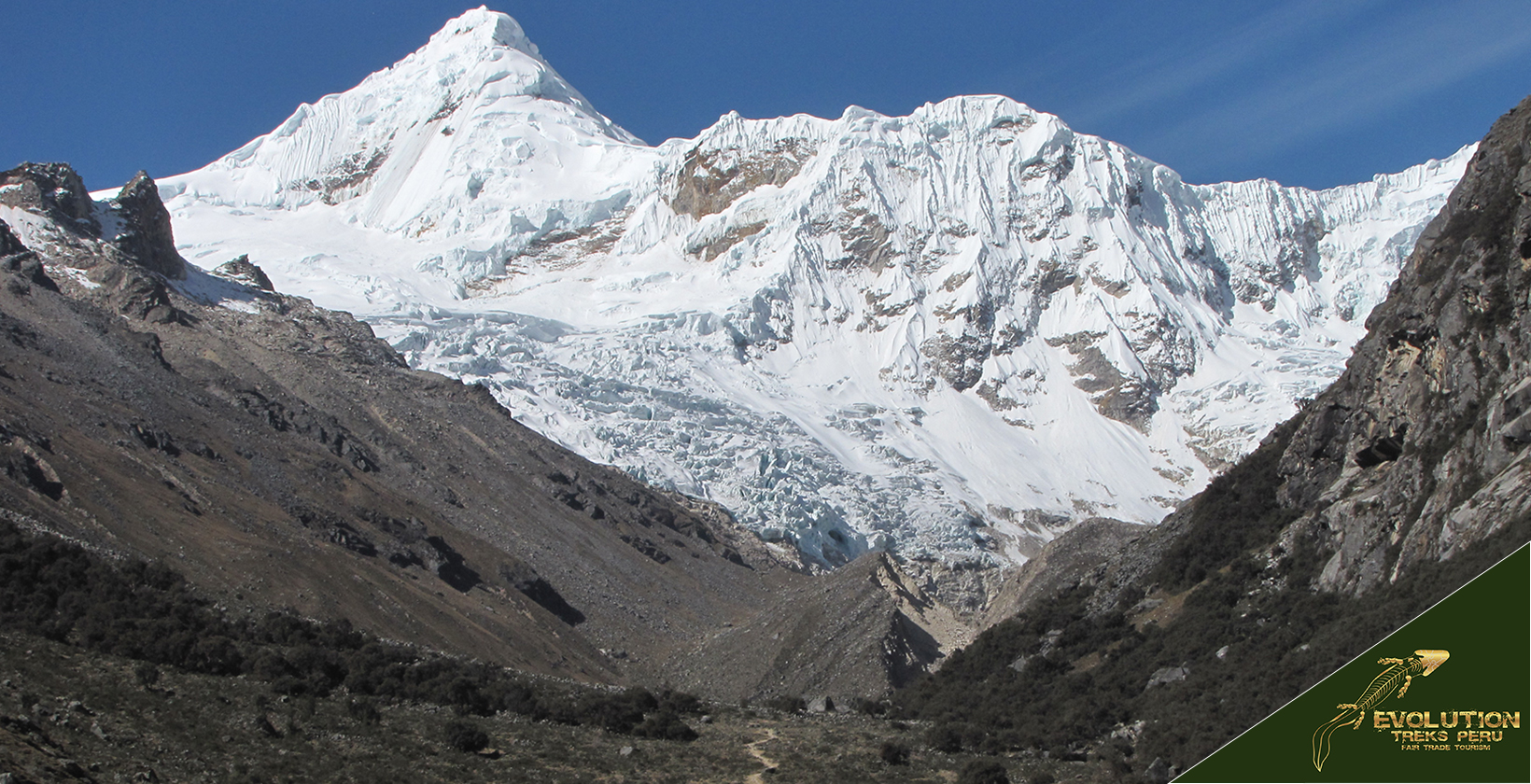
Where to stay in Tocllaraju?
The peak of Tocllaraju provides no permanent residence, yet scattered around its base are several small settlements where wanderers can find temporary refuge amidst their travels through the pale summits. A handful of these sanctuaries include:
The settlement acts as the most populated area in these parts and serves as a favored starting point for venturing into the White Mountains. Huaraz puts forward an array of lodgings, spanning from low-cost dormitories to lavish inns, not to mention eateries, stores, and additional conveniences.
Caraz: The municipality sits 60 minutes south of the bustling city of Huaraz and exudes a calmer, relaxed ambiance. Caraz contains various diminutive lodgings, hostels, bazaar, and other stores.
“This settlement can be found roughly 60 minutes from Huaraz, heading north, and is renowned for its picturesque gardens and time-honored building designs. Yungay possesses a handful of miniature lodges, boarding houses, and eateries and stores.”
A small settlement can be found where the immense Tocllaraju rises from the land. Though lacking established lodging, trekkers embark on the ascent commonly secure shelter within villagers’ homes.
Additional abodes and encampments are positioned within the Cordillera Blanca chain itself, which can furnish a profoundly captivating and daring undertaking for tourists. Though, these selections usually necessitate further developed scheduling and arrangement.
What are the Tours for Tocllaraju?
Multiple expeditions can be arranged for sightseers desiring to traverse Tocllaraju and the encompassing White Mountain range. The durations and challenges of these journeys differ but can be tailored to match the necessities and curiosities of lone wanderers. Presented here are a few illustrations:
An ascent of Tocllaraju: This expedition, spanning numerous sunrises, furnishes direction for veteran peak scalers aspiring to vanquish Tocllaraju. Conveyance, shelter, victuals, and adept trailblazers and gear are provided throughout the trek.
The gorgeous Huayhuash range provides a multi-sunrise trek for explorers through the peaks and dales of the Cordillera. Though demanding bodily vigor, splendid vistas of encircling summits and glens greet visitors.
The paths wind their way through the pale peaks of the Cordillera Blanca, a many-day journey with vistas of the lofty and picturesque. Less arduous than other ventures nearby, the Santa Cruz trek can be traveled with leadership or alone.
Cultural Excursions: Various cultural excursions present themselves around the vicinity concentrating on the chronicles and customs of the mountainous terrain. These excursions could comprise drop-ins to nearby bazaars, ancient places, and native populations.
The Andes mountain range requires a notable amount of physical stamina and the capacity to trek at great heights for numerous explorations in the Cordillera Blanca vicinity. Adventurers must forever enlist the assistance of veteran pathfinders and outfitters and be primed for any type of atmospheric conditions.
What are the Closest Destinations to Tocllaraju?
In the Andes Mountains of Peru, near the settlement of Huaraz, is Tocllaraju. Although the region offers various appealing places, a few stand out. For instance:”
The boundaries of the Huascaran National Park encircle a large portion of the White Mountains and provide breathtaking vistas of the adjacent summits and dales; within the park there are diverse lofty peaks, most notably Huascaran, Peru’s tallest point.
The ruins of Chavin de Huantar reside around 100 kilometers south of Huaraz. This locale harbors vestiges and sanctuaries tracing to the Chavin people, who thrived in these lands between 900 to 200 years before our common era.
The icy lake rests in solitude thirty and five kilometers from the setting sun of Huaraz, renowned for its vibrant cerulean waters and the grand peaks which stand guard—a favored haunt of wanderers and climbers alike seeking refuge from the din of civilization.
Llanganuco Lakes: Situated roughly 30 kilometers northward of the town Huaraz, a pair of lakes are enveloped by breathtaking peaks and proffer pursuits like trekking, angling, and various open-air recreations.
The peaks of dark mountains rest westward of the white peaks, revealing an alternate vista of the locale’s striking natural splendor. Known for heights less lofty and weather more temperate, the summits swathed in night entice many a wanderer to tread their trails.
The various locations remain accessible from the settlement of Tocllaraju, reachable whether by motor vehicle or public transport starting in Huaraz.
How to Get from Cusco to Tocllaraju?
The trek from the ancient Incan capital to the peak in the Andes requires traversing by motorcoach and foot, for Tocllaraju stands amidst the pale mountains. This is what’s entailed:
One can embark on a lengthy voyage from the ancient Incan city of Cusco to the mountaineering hub of Huaraz by bus. Multiple transport outfits provide passage connecting the two destinations, separated by a trek of around eight to ten hours, contingent on the flow and state of the roadways.
After reaching Huaraz, sightseers can locate lodging and set up a way to get to the beginnings or base camps of Tocllaraju or nearby summits. Numerous trip organizers and outfitters operate in Huaraz and can furnish leaders, gear, and other provisions for visitors.
The passage to Tocllaraju will depend on the particular schedule and ascending or hiking designs. Tourists can select to ascend Tocllaraju straightforwardly or to march or climb other close-by peaks or paths in the Cordillera Blanca extend. It’s critical to cooperate with experienced guides and outfitters and to pursue nearby guidelines and security rules while in the area.
The voyage to the peak of Tocllaraju demands exceptional endurance and the capacity to trek at lofty heights. Adventurers must be equipped for any meteorological circumstances and ought to seek medical counsel antecedent to endeavoring elevated elevation pursuits.
What to know before going to Tocllaraju?
Prior to embarking on your journey to Tocllaraju, it’s important to be well informed to have an enjoyable experience. Consider the following information:
- Physical Fitness: Tocllaraju is a high-altitude mountain with demanding terrain. It is crucial to possess mountaineering experience and maintain physical fitness. Cardiovascular and strength training exercises and altitude acclimatization are highly recommended.
- Acclimatization: Adequate acclimatization is key to preventing altitude sickness and ensuring an ascent. It is advisable to spend a day in Huaraz or nearby areas allowing your body to adjust to the altitude before climbing. Acclimatization hikes, such as Laguna Churup, come highly recommended.
- Technical Skills: A basic understanding of mountaineering skills is necessary for Tocllaraju, including rope techniques, glacier travel, and crevasse rescue. Take the time to familiarize yourself with these skills, or consider enlisting the assistance of a certified guide or joining a guided expedition.
- Weather Conditions: Weather conditions in the Cordillera Blanca can be unpredictable, with changes in temperature and the potential for storms. Before your trip, check the weather forecast diligently. Come prepared for shifting conditions. Dressing in layers and bringing gear for temperatures, strong winds, and precipitation is essential.
5.. Equipment: The gear and equipment is paramount for a climb. When climbing Tocllaraju, it’s essential to have the gear, like mountaineering boots, crampons, an ice axe, a helmet, a harness rope, and suitable clothing for wet weather. Consult climbers or guides to get a comprehensive list of equipment.
To ensure a climbing experience, know the regulations and permit requirements for Tocllaraju. Since it’s situated within Huascarán National Park, obtaining the permits and following park rules is important.
Huaraz is a town in the region. Serves as a base for climbers. It has accommodations, gear rental shops, and mountain guide services. Utilizing these resources can provide you with information, help with transportation arrangements, and assistance if needed.
Remember that mountaineering always involves risks. It’s crucial to assess your abilities and limitations and prioritize safety when making decisions. Be prepared for hazards like crevasses, rockfalls, and avalanches. Traveling with a partner or guide is advisable to ensure safety throughout your journey.
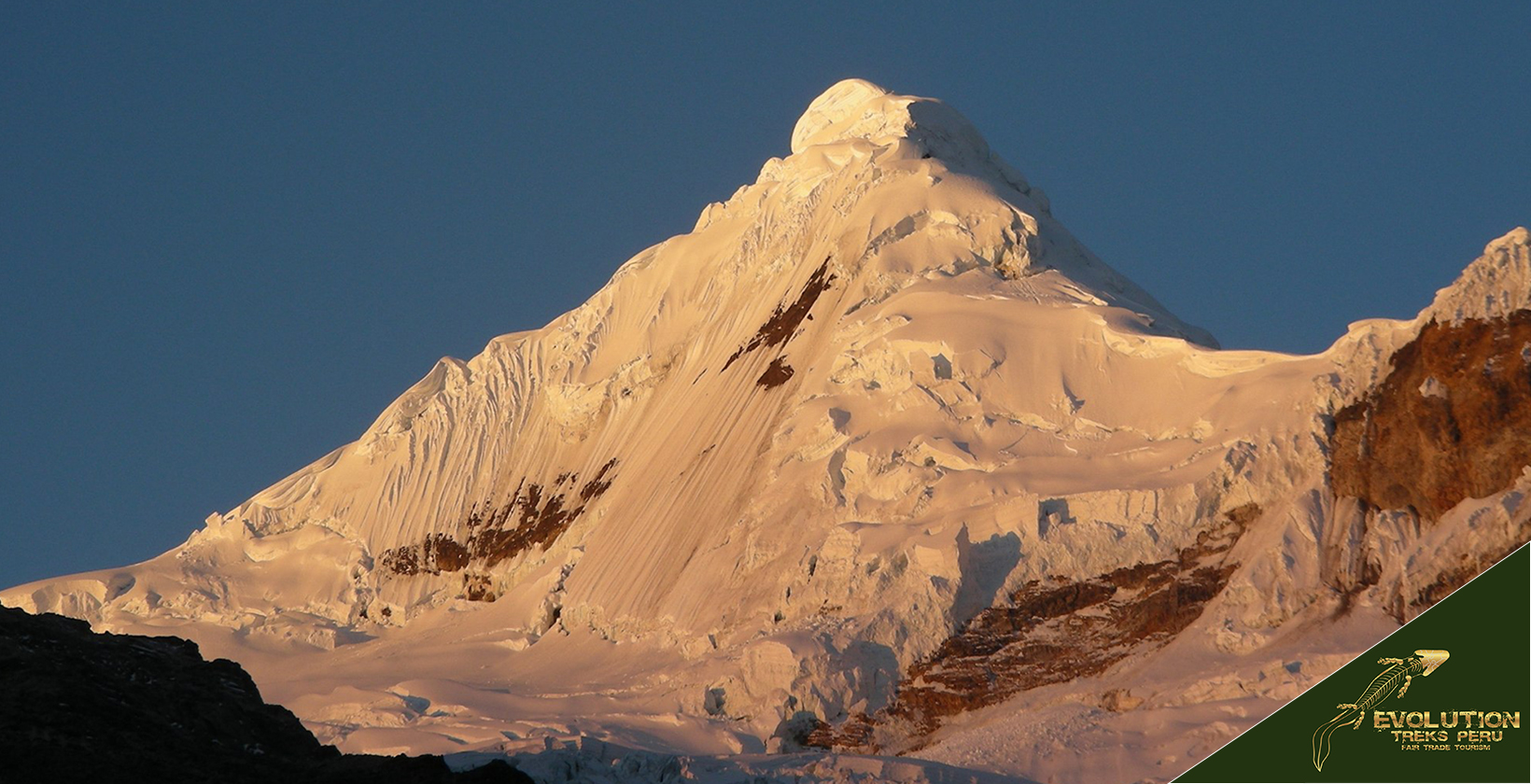
How is the Tocllaraju Itinerary?
Here is the itinerary for the Ishinca & Tocllaraju Expedition:
Day 1: Upon arrival in Lima, Peru, we will have a welcome dinner.
Day 2: We will then transfer to Huaraz.
Day 3: On this day, we will check our gear. Acclimatize to the altitude.
Day 4: As part of our acclimatization process, we will hike to the Laguna Churup.
Day 5: It’s time to go to the trailhead and hike towards Ishinca basecamp.
Day 6: Take a moment to rest and practice our mountaineering skills.
Day 7: We will venture onwards. Reach Ishinca camp.
Day 8: The big day has arrived! It’s time to push for the summit of Ishinca and then return to base camp.
Day 9: A deserved rest day awaits us at Basecamp.
Day 10: Our next destination is Moraine camp, which we will hike towards.
Day 11: Another summit push awaits us, this time for Tocllaraju. We will then return to base camp.
Day 12: Filled with memories, we will hike out. Make our way back to Huaraz.
Day 13: A celebratory dinner in Huaraz marks the end of our expedition. To return to Lima, we will take a bus.
Day 14: This day is dedicated to sightseeing in Lima. Enjoying a team dinner together.
Day 15: Sadly, it is time for departure.
How much does it cost to visit Tocllaraju?
The expenses when planning a trip to Tocllaraju can differ based on factors. These factors include the organizing company, the duration of the journey, the degree of assistance and amenities offered, and other logistical considerations. Typically a 14-day tour would range in price from $3,995 to $4,500.
Some organizers provide the Ishinca & Tocllaraju Expedition package. They offer an itinerary for the expedition, which covers accommodation, meals, transportation, and guidance services. However, the exact cost of the expedition should be mentioned on their website.
Please remember that expedition costs include permits, guide fees, equipment rental, transportation, accommodation, meals, and other services. Additionally, prices may vary depending on factors like the number of participants and the customization or assistance provided during the expedition.
How many hours should a person spend in Tocllaraju?
The duration of one’s vacation within the boundaries of Tocllaraju is contingent upon the particular undertakings and schedule devised. The succeeding provisions offer broad recommendations:
Ascending the peak of Tocllaraju usually necessitates a multitude of sunrises, contingent on the precise trail and skill. Sojourners ought to intend to linger a minimum of 5 to 7 days in the vicinity, encompassing time for adaptation, preparation, and ascent.
Exploring by foot: A few wandering and trailblazing choices lie within the White Mountain chain, encompassing the Holy Cross path, the Huayhuash trail, and more. These travels can change in span and hardship but commonly take nearly a week to finish.
The region’s stunning scenery and historic locations are still accessible for visitors with limited time or inclination for extended outdoor adventures. Brief excursions lasting a day or two can transport one to natural wonders like Churup Lake and Sixty-Nine Lake or ancient cultural centers such as Chavin de Huantar. These compact itineraries preclude the necessity of overnighting in the wilderness yet furnish glimpses of the area’s diverse allurements.
Overall, those traveling to witness Tocllaraju and the White Mountain Range should allocate adequate time, ideally multiple days, to absorb the breathtaking natural splendor and cultural wealth the territory offers.
What is the nearest city to Tocllaraju?
The adjacent metropolitan to Tocllaraju would be Huaraz, positioned within the Ancash locality of Peru. Huaraz reigns as the most voluminous municipality in the territory and operates as the predominant station for frequenting the neighboring Cordillera Blanca belt, inhabiting Tocllaraju and further aerial summits. Huaraz is seated around 110 kilometers northeast of Tocllaraju and can be accessed via coach or private transport.
Who are the most famous climbers that climbed Tocllaraju?
The sources provided do not specify the names of climbers who have successfully climbed Tocllaraju. However, Tocllaraju is a known mountain in the Perus Cordillera Blanca range. It has attracted numerous mountaineers over the years.
Tocllaraju is popular among climbers who have some experience and seek challenging yet ascents as it offers one of the most difficult normal routes among the 6000-meter peaks in the area. Many climbers choose to climb Tocllaraju as a way to acclimatize before attempting mountains.
Since its ascent in 1939 by Walther Brecht and Hans Schweizer, Tocllaraju has gained recognition for its breathtaking beauty and appealing slopes. It remains a sought-after destination for mountaineers exploring the Cordillera Blanca.
Although specific names of climbers who have conquered Tocllaraju are not mentioned in the sources, it is common for experienced mountaineers and expedition teams to include this mountain as part of their climbing experiences in the region.
It’s important to note that the lack of information about climbers does not diminish the significance and allure of Tocllaraju as an outstanding climbing destination in the Cordillera Blanca.
How is the Preservation of Tocllaraju?
Protecting Tocllaraju and its neighboring peaks of the White Mountain Range is crucial for groups locally and nationally in Peru. The following are manners in which the locale is safeguarded:
The mountainous area houses various guarded territories, encompassing the Huascaran Federal Park instituted in 1975 to safeguard the locale’s innate and social fortunes. These watched-over regions give fundamental living space for various greenery and creature species, just as chances for amusement and the travel industry.
Persistent organizations locally and nationally aspire to advance supportable tourism customs in the Cordillera Blanca region, striving to decrease undesirable influences on the surroundings and nearby populaces while backing financial progression. These practices include capping the number of sightseers to precise vicinities, promoting accountable waste regulation, and sustaining indigenous enterprises and communities.
Monitoring the glaciers: The movement of glaciers disappearing is worrying those in the white mountain range, with groups locally and nationally attempting to keep watch over and learn about how this happening will affect the region’s environments and water systems. This looking into the matter is helping decide how best to look after and control the area.
The mountain peaks offer sanctuary to several native groups, whose time-honored customs and legacies shape an integral element of the locale’s ancestry. Grassroots collectives and national bodies strive to buttress these peoples and champion safeguarding their cultural riches.
The conservation of Tocllaraju and its mountain range remains an intricate, constant undertaking necessitating the alliance of diverse contributors, encompassing official authorities, nearby inhabitants, and sightseers. In cooperating to advance supportable strategies and safeguard the zone’s organic and social fortunes, it is trusted that Tocllaraju and its environs will continue flourishing for ages to come.
What are the differences between Tocllaraju and Ausangate Mountain in Cusco?
Tocllaraju and Ausangate are two mountains, in Peru. Tocllaraju situated in the Cordillera Blanca range in the Ancash Region features snow covered slopes and attractive ridges making it a great choice for mountaineers with experience. Among the 6000 meter peaks in Cordillera Blanca Tocllaraju is considered one of the routes.
On the hand Ausangate, located in the Cusco Region is renowned for its trekking route known as the Ausangate Trek. This multi day adventure takes hikers through the landscapes of the Vilcanota mountain range. Along the way trekkers are treated to breathtaking views of Ausangate Mountain and its neighboring peaks as high altitude passes, vibrant lakes and interactions with local Andean communities.
While both Tocllaraju and Ausangate offer experiences, in the Peruvian Andes they differ in terms of their locations, activities (trekking vs. Mountaineering) and specific features of their respective routes.
Is Tocllaraju in danger?
Tocllaraju is currently not in danger. Tocllaraju, a mountain in the Cordillera Blanca range in Peru, is widely renowned for its breathtaking beauty and alluring slopes and ridges [2]. Nevertheless, it is important to acknowledge that mountaineering activities inherently carry risks, and climbing any mountain, including Tocllaraju, necessitates preparation, experience, and adherence to safety protocols.
Mountains like Tocllaraju are exposed to hazards such as avalanches, rockfalls, unpredictable weather conditions, and altitude-related dangers. Aspiring climbers should possess in-depth knowledge of mountaineering techniques, utilize gear and ensure their physical fitness is in order before embarking on the ascent of Tocllaraju or any other challenging summit.
Staying updated on weather conditions seeking guidance from guides or mountaineering organizations, and making well-informed decisions based on individual capabilities and prevailing circumstances at the time of the climb are vital for climbers. In mountaineering expeditions prioritizing safety should always be paramount.

Miguel is a professional tour guide from Cusco, Peru, with almost 20 years of experience leading tours and a deep knowledge of Peru’s cultural and ecological diversity. He is also an advocate of ecotourism and cultural sensitivity and has lectured on these topics in the US and Europe. He co-founded Evolution Treks Peru, a worker-owned travel company based in Cusco.

